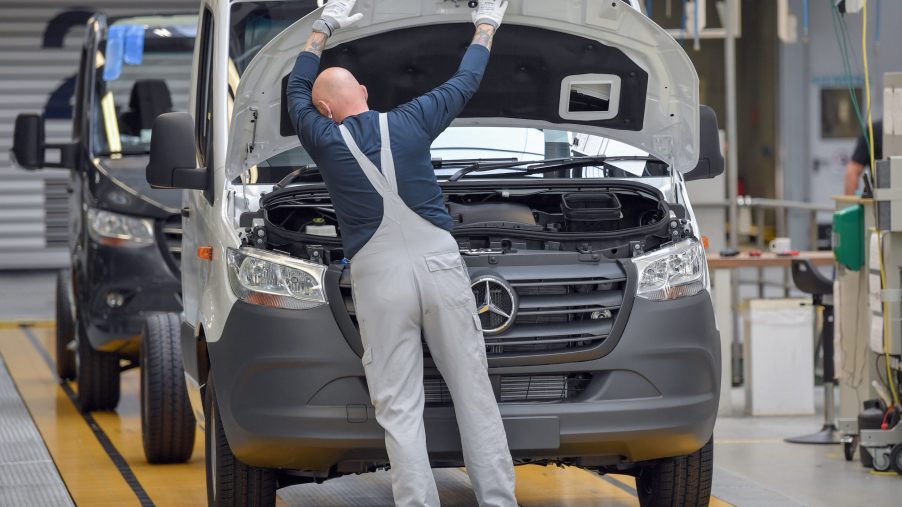
This Mercedes-Benz Sprinter Diesel Will Assault Your Ears
Mercedes-Benz knows how to make an impact, and it’s not afraid to ensure that its voice is heard. It vies for the top position in terms of luxury, features, and power. Apparently unwilling to settle for Best in Class, the brand has recently been sweeping a new category with many of its vehicles: loudest in class. Fancy in-car entertainment systems have made many passengers think that bringing personal headphones for road trips is no longer necessary. But the ear-splitting driving decibels of one Mercedes-Benz Sprinter Diesel, in particular, might have van passengers reaching for some . . . of the noise-canceling variety.
The Mercedes-Benz Sprinter is big and bold
Since its debut in 1995, the Mercedes-Benz Sprinter vans have commanded attention and the road. As Daimler Media notes, the vehicles helped to define an entirely new class of heavy, powerful vans. Tucked away in the manufacturer’s Düsseldorf plant, the first rendition of the Sprinter was quietly challenging the common van standards for construction, engines, and interior design.
Although true Mercedes Sprinters have been on the market for only a few decades, their inspiration can be found in the 19th century. According to Business Insider, Carl Benz made the first motorized van in 1896, built with a large, detachable body and intended for delivery. It could be viewed as a compact semi-truck, but it also bears a surprising resemblance to the modern-day Sprinter. The key difference is found in the car’s interior — not only the upgraded technology but the plush, luxury seating that has replaced the cargo storage.
The Sprinter has especially shined in the European market, a frequent favorite for toting tourists or large families. Its one-of-a-kind shape and style make it easy to spot on the road and, according to a recent study, its sound helps as well.
Car and Driver put its volume to the test
For some, the coolest cars are the ones that cause a commotion. We’ve all witnessed a loud sports car go speeding by or a luxury vehicle revving its engine at a stoplight. In the moment, these noises can seem deafening. Car and Driver decided to test if they really are. In a February article, they released the loudest vehicles in each market segment, scored based on measured decibel.
In the van class, the big winner was none other than a Mercedes-Benz Sprinter — specifically, the 2019 Sprinter 3500XD Diesel DRW. At 84 dBA, the vehicle was quieter than the coupe or convertible competitors, but still quite noisy. And in contrast to the winners of other categories, the Sprinter isn’t designed to be so loud.
According to the report, the volume is mainly attributed to its dual-rear axle and turbo-charged engine. The spacious design also doesn’t do it any favors, leaving plenty of room for noise to bounce and echo around.
Mercedes owners may be driving to the ear doctor
According to the CDC, 80-85 dBA is a mostly safe noise level to be exposed to. This range is typically akin to bustling city traffic and causes, at most, annoyance. Still, after hours of exposure, some mild hearing damage could occur. Tuning into a Mercedes-Benz Sprinter’s symphony for too long could have similar effects to using a leaf blower without ear protection.
Two other Mercedes vehicles made Car and Driver’s list, proving that the company has mastered the art of attention-grabbing. Apparently, the famously loud Mercedes-Benz Stadium would be on-brand even without the big logo on the building.


